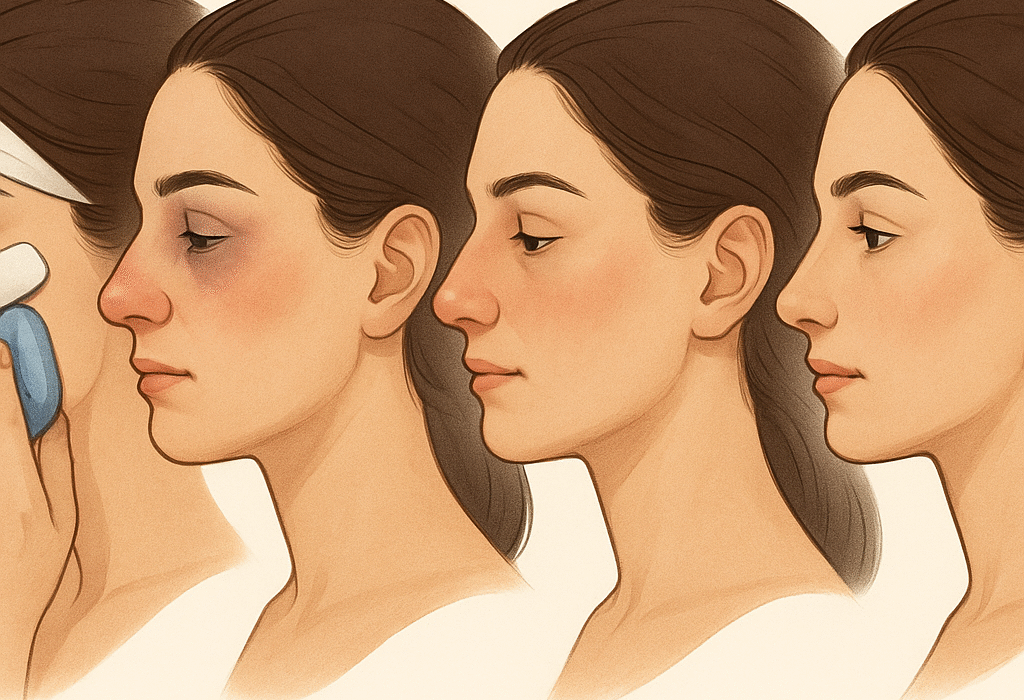When Does Swelling Go Down After Rhinoplasty? A Comprehensive Recovery Guide
Rhinoplasty, also known as a nose job, is a popular surgical procedure for individuals seeking to improve both their aesthetic appearance and breathing function. One of the most frequently asked questions and concerns during this process is: When does swelling go down after rhinoplasty? Swelling after rhinoplasty is a completely natural part of the healing process, and patience is key during this period. Let’s take a step-by-step look at the recovery timeline and how swelling subsides. Understanding when does swelling go down after rhinoplasty is crucial for managing expectations.
When Does Swelling Go Down After Rhinoplasty? Detailed Timeline
First 48 Hours: Peak Swelling and Initial Interventions
During the first two days following surgery, swelling after rhinoplasty and bruising reach their peak. The body begins its repair process, and tissues naturally retain fluid. In this critical period, keeping your head elevated, applying regular cold compresses as advised by your doctor, and adhering to all medical recommendations will help minimize rhinoplasty swelling. The initial answer to when does swelling go down after rhinoplasty begins with proper management during these first 48 hours.
Weeks 1-2: Rapid Improvement and Bruising Subsides
Within the first week, especially between days 3 and 5, bruising may darken. However, towards the end of the week, these bruises begin to fade significantly, and swelling after rhinoplasty decreases considerably. By the end of this period, most people can comfortably return to work or their social lives. The splint and bandages on the nose are usually removed at the end of the first week. The first noticeable answer to when does nose swelling go down becomes apparent in these weeks, and the healing process accelerates. During this time, the initial significant steps towards answering when does swelling go down after rhinoplasty are taken.
Weeks 2-4: Nose Contours Become More Defined and Edema Monitoring
Between the second week and the end of the first month, there is a noticeable improvement in the overall appearance of the nose. A large portion of the swelling will have subsided. While the bridge and dorsum of the nose appear clearer, slight rhinoplasty edema may persist in more sensitive areas like the nasal tip for a while longer. You will notice that swelling after rhinoplasty has significantly reduced at this stage, but patience is still required for the final result.
Months 1-3: Nasal Shape Emerges and Swelling Decreases
After the first month, the nose begins to look more natural. By the third month, most of the prominent swelling will have completely disappeared. A slight fullness may still be felt at the nasal tip during this period, but it typically does not affect daily life. For those wondering when does swelling go down after rhinoplasty, this period marks a significant stage where the main contours of the nose become clearer.
Months 3-6: Nasal Form Refines and Fine Swelling Disappears
After the third month, the new and final shape of the nose becomes even more defined. Apart from minor rhinoplasty edema, there is no significant swelling left. The bridge and dorsum of the nose, in particular, almost reach their final form. Patients generally feel that their nose is very close to its final appearance during this period. The majority of swelling after rhinoplasty resolves during this phase. At this stage, a large part of the question when does swelling go down after rhinoplasty is answered.
Months 6 – 1 Year: Progressing Towards the Final Result
From the sixth month onwards, the nose enters the final stretch of its healing journey. By the end of one year, almost 100% of swelling after rhinoplasty will have subsided, and the nose will have achieved its final appearance. During this period, the nose becomes more natural, smooth, and has finer contours. This process provides the full answer to when does swelling go down after rhinoplasty.
After 1 Year: Fine Details Settle and Full Recovery
Especially in individuals with thicker skin, very slight rhinoplasty edema may persist for up to 12-18 months. However, this is usually not noticeable, and the nose generally achieves its final shape. Even after a year, understanding when does swelling go down after rhinoplasty can involve these subtle final adjustments.
Tips to Reduce Swelling After Rhinoplasty
To help swelling after rhinoplasty subside faster and support the recovery process, here are some important points to consider:
Keep Your Head Elevated: Especially for the first two weeks, keep your head elevated by using two or three pillows while sleeping to help reduce edema.
Apply Cold Compresses: Regularly applying cold compresses during the first 72 hours significantly reduces nose swelling.
Drink Plenty of Water, Reduce Salt: One of the most effective ways to eliminate edema from the body is adequate water intake. Avoiding salty and processed foods is also beneficial.
Avoid Smoking and Alcohol: Smoking and alcohol consumption for at least a few weeks can negatively impact healing and increase swelling.
Consider Lymphatic Massage: With your doctor’s approval, gentle lymphatic massages 2-3 weeks after surgery can support faster resolution of rhinoplasty edema.
Protect from the Sun: Protect your nose from direct sunlight for the first few months to prevent increased swelling.
Engage in Light Exercises: Again, with your doctor’s advice, light walks can improve blood circulation and aid in edema reduction.
Conclusion: Aesthetic Perfection Through Patience
Swelling after rhinoplasty is a normal and expected part of the process for every patient. During this period, it is crucial to be patient, strictly follow your doctor’s advice, and let the process unfold naturally. Don’t let the reflection in the mirror during the first few weeks mislead you; your nose will become more beautiful each day and achieve the natural look you desire. Remember, beautiful and lasting results take time, but this patience will ultimately lead to a confident appearance! Since each patient’s recovery process may vary, it is important to remember that there might be individual differences in the timelines provided. For personalized answers to when does swelling go down after rhinoplasty, always consult your doctor.


